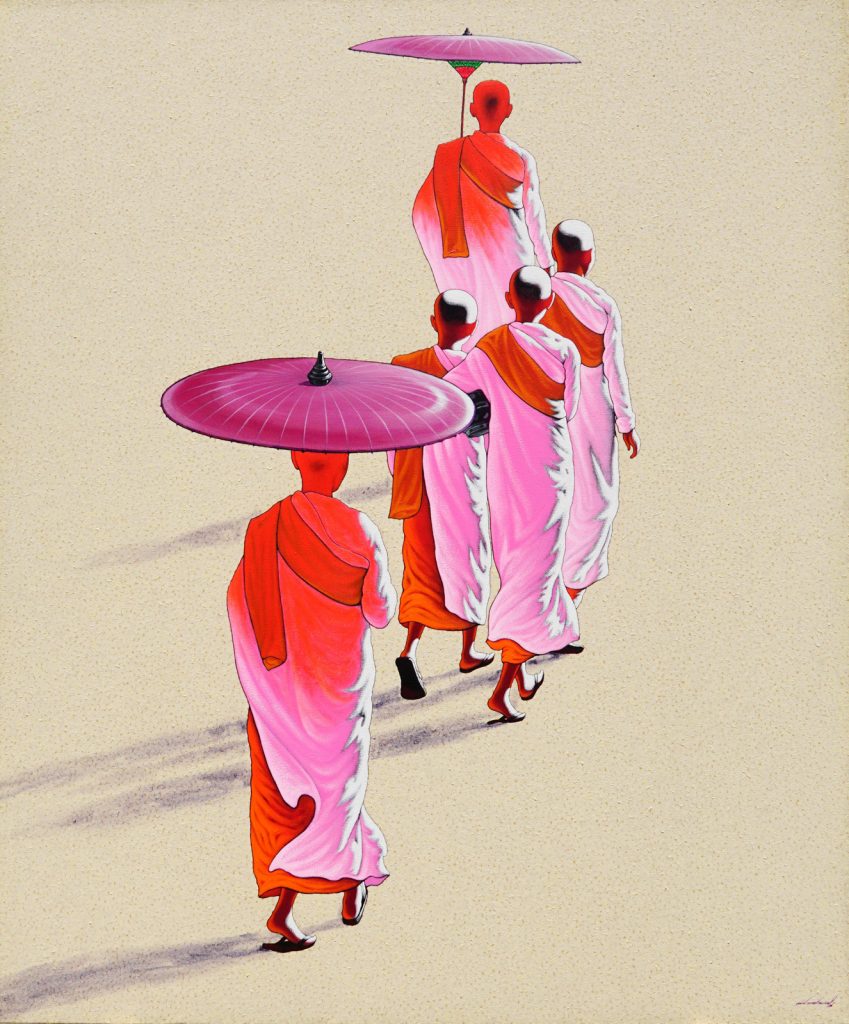Imagine all of Buddhist history condensed into a single day: Buddha’s enlightenment occurs at dawn, and our present moment falls at dusk. The great teacher Bodhidharma would arrive in China comfortably before lunch, while Eihei Dogen would bring his vision of Zen to Japan just in time for afternoon tea. There would be less than an hour of daylight left when Buddhism finally reached America. The first Westerners would not ordain until the sun had begun to dip well below the horizon.
Women, on the other hand, would have joined the sangha somewhere in the first 15 minutes.
The First Free Women: Original Poetry Inspired by the Early Buddhist Nuns
By Matty Weingast
Shambhala Publications, February 2020 (1st edition), June 2021 (2nd edition), $16.95, 160 pp., paperback
Those first intrepid nuns left their words to us in poems recorded in the ancient collection Therigatha, or verses of the elders, found along with the Buddha’s own teachings in the Pali canon of the Theravada. Now Matty Weingast, a longtime meditation practitioner, has breathed new life into these early texts with The First Free Women: Poems of the Early Buddhist Nuns, a beautiful, endlessly moving collection of their words transformed into modern English.
Their arresting clarity comes through in the very first verse, traditionally attributed to an unnamed bhikkhuni (nun), or sometimes to Therika, meaning “little theri,” or “little elder”:
Rest, my heart,
wrapped in these
simple robes
you sewed yourself
Like a pot of herbs
left cooking overnight,
that which was boiling
has boiled away.
That which was on fire
has all turned to ash.
This is but one of many poems that vividly capture these women’s fully awakened minds. Others reflect on the lives they led before taking their monastic vows, such as this from “Grandma Sumana”:
After
all those years
looking after others,
this old heart
has finally
learned
to look
after itself.
Each act of kindness
a stitch in this warm blanket
that now covers me
while I sleep.
These poems can also serve as a reminder of what was lost when the original bhikkhuni lineage died out in the Theravada heartland of south and southeast Asia nearly a thousand years ago. Ordination offered these women twofold liberation—from both the world of men and the world at large:
So this is what it feels like—
to be free.
Forever free
from playing the mortar
to my crooked husband’s
crooked pestle. Enough.
For my mother.
For my daughter.
And for all the daughters I might have had.
The cycle ends here.
***
This collection is far from the first rendering of these poems into English. The remarkable British scholar Caroline Rhys Davids published a lyrical, almost biblical translation over a century ago. A prolific translator of early Buddhist texts, Rhys Davids was later named president of the esteemed Pali Text Society founded in 1881—one of two women to serve in that capacity. Although her verse can feel archaic today, it has remained in print and was reissued a decade ago paired with a more modern prose translation as Poems of the Early Buddhist Nuns. More recently, the Harvard lecturer Charles Hallisey published a handsome bilingual edition, Therigatha: Poems of the First Buddhist Women, in the Murty Classical Library of India published by Harvard University Press.
Weingast’s poems, in contrast, are more reimaginings than they are direct translations, and at times he takes considerable liberties with the Pali sources. For this reason, it can be jarring to compare his versions to the earlier editions. And yet the nuns’ voices, not his own, are what shine through. It is as if he has brought these wise women back to life, conjuring the poems they might have written if they were walking among us today.
It seems particularly fitting that Weingast wrote much of this book as a guest at the Aloka Vihara Forest Monastery, a bhikkhuni community in the foothills of California’s Sierra Nevada mountains. The recent resurrection of this ancient Theravada lineage by these and other pioneering women has been fraught with controversy. After allowing women into the sangha, the Buddha ultimately decreed that future nuns should be ordained by both bhikkhus and bhikkhunis. This created a problem when there were no longer any bhikkhunis around to ordain later generations. Modern Buddhists have overcome this apparent obstacle by either enlisting the help of bhikkhunis from other lineages or ordaining new bhikkhunis (like the original bhikkhunis) by monks alone.
Bhikkhuni Anandabodhi, one of the senior nuns at Aloka Vihara, offers an inspiring foreword to The First Free Women; she calls the bhikkhuni revival “a natural reemergence of what has been kept down for so long—a birthright that can now, at last, be reclaimed.” Bhikkhuni Anandabodhi and her sisters at Aloka Vihara and beyond are reminders that the question of bhikkhuni ordination is no longer a question. We already have modern-day theris walking among us again.
For scholars or practitioners looking for a more literal translation of these ancient texts, Hallisey’s edition will be a better bet. But for anyone looking to be inspired by the present possibility of awakening that is demonstrated by our first women ancestors, Matty Weingast’s blessed book will be a most welcome companion. What an astonishing surprise to reach all the way back to the dawn of our sangha and discover these modern treasures.
♦
Due to concerns that the original presentation of this book may have given the false impression that it consisted of literal translations of the Therigatha, Shambhala Publications announced that it would publish a second edition with a revised title, The First Free Women: Original Poetry Inspired by the Early Buddhist Nuns, due out in June 2021. Learn more here.
Thank you for subscribing to Tricycle! As a nonprofit, we depend on readers like you to keep Buddhist teachings and practices widely available.
